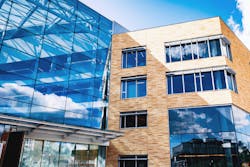Business school facility at Carnegie Mellon receives LEED Gold
The first building on the David A. Tepper Quadrangle at Carnegie Mellon University in Pittsburgh has received LEED Gold certification for its environmentally friendly design and construction.
The facility, which opened in 2018, houses the university's Coulter Welcome Center and the new home for the Tepper School of Business.
"From the start, the Tepper Quad was planned as a green building," says Tepper School Dean Robert Dammon. "It is gratifying that LEED has recognized the significant efforts of our planning committee with a Gold certification. We maintain our commitment to sustainable operations in our occupation of the Tepper Quad."
Several elements of the building construction—including a 120,000-gallon cistern to collect rainwater for reuse—were planned with the certification in mind.
One innovative feature that reduced the volume of carbon in the building by about 30 percent is called "voided slab methodology." This system involves replacing some of the concrete in floor slabs with hollow plastic balls, made from recycled plastic.
The BubbleDeck technique makes lighter, thinner floor slabs possible and reduces the need for structural support such as concrete caissons and steel girders. The building in the Tepper Quad space is the largest construction project in North America to this point to use BubbleDeck.
One of the highest design priorities was the atrium, a large open space in the center of the building encased in a four-story glass curtain. Such a large expanse of glass makes it difficult to maintain the building's temperature, so the Campus Design and Facility Development team found ways to mitigate the heat gain.
The glass is "fritted," which means it has a translucent ceramic coating that counteracts glare and reduces direct sunlight into the space. In addition, the floor surfaces in the atrium use radiant slabs, which incorporate pipes that circulate liquid to provide heating and cooling from below.
About the Author
Mike Kennedy
Senior Editor
Mike Kennedy, senior editor, has written for AS&U on a wide range of educational issues since 1999.
